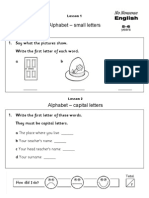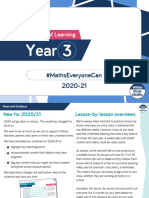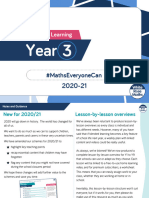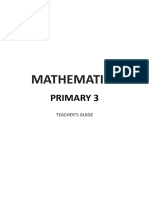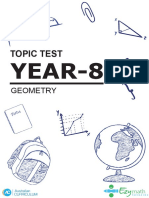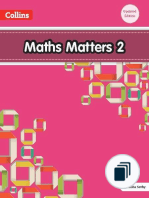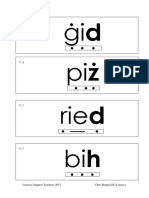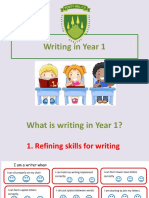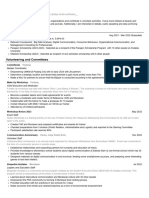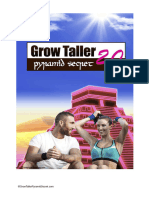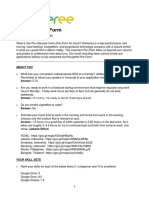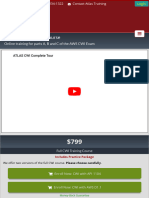Maths in Year 1
Maths in Year 1
Uploaded by
Mar AttardCopyright:
Available Formats
Maths in Year 1
Maths in Year 1
Uploaded by
Mar AttardOriginal Description:
Original Title
Copyright
Available Formats
Share this document
Did you find this document useful?
Is this content inappropriate?
Copyright:
Available Formats
Maths in Year 1
Maths in Year 1
Uploaded by
Mar AttardCopyright:
Available Formats
Maths in Year 1
Aims of this morning’s meeting
• To gain an understanding of the National
Maths curriculum and expectations.
• To take part in a variety of Maths activities.
• To get an insight into how Maths is taught at.
• To take away some ideas to support your
children at home.
What is maths in Year 1?
1. Number skills
What is Maths in Year 1?
2. Measurement, Geometry and Statistics
You may feel overwhelmed by
seeing this many objectives.
Don’t be, let’s have a look at how
and why all of the pieces fit
together.
Progression of expectations
EYFS Year 1 Year 2
Count reliably up to 10 objects Count to and across 100, forwards and Pupils count fluently forwards and backwards
backwards, beginning with 0 or 1, or from any in 10s, starting at any 1 or 2 digit number
given number
Estimate how many objects they can see identify and represent numbers using objects Place and identity 2 digit numbers on a
and check by counting and pictorial representations including the number line using their understanding of how
number line close the numbers are to multiples of 10
Use language such as ‘more’ or ‘fewer’ to use the language of: equal to, more than, less Pupils recognise commutativity as the
compare two numbers than (fewer), most, least relationship between subtraction and
addition. Subtraction meaning take away,
difference, how many more.
Recognise numerals 1-9 read and write numbers from 1 to 20 in
numerals and words.
Count aloud in ones, twos, fives or tens count, read and write numbers to 100 in count in multiples of twos, threes, fives and
numerals; tens from any given number
count in multiples of twos, fives and tens
The Maths Curriculum
Children should:
• Become fluent in the fundamentals of mathematics, including through
varied and frequent practice with increasingly complex problems over
time, so that pupils develop conceptual understanding and the ability to
recall and apply knowledge rapidly and accurately.
• Reason mathematically by following a line of enquiry, conjecturing
relationships and generalisations and developing an argument,
justification or proof using mathematical language.
• Solve problems by applying their mathematics to a variety of problems
with increasing sophistication, including breaking down problems into a
series of simpler steps and persevering in seeking solutions.
Approach to Maths
at Forty Hill CE School
= + x %
subtract
add
multiply
divide
greater than
When we plan a Maths sequence we
always ensure children are exposed to
correct mathematical language, symbols
(+ - = x), an image and a context.
Are you sitting comfortably?
Maths through Literacy
Learning Objective:
To find and name a quarter of a
quantity.
Success Criteria:
Must- I must put be able to groups objects to
find a quarter
Should- I should be able to show a quarter of an
even number within 20.
Could- I could even solve a one step problem
involving a quarter of a quantity.
Together we….
• Discuss mathematical vocabulary.
• Model and explore the concepts as a whole Class
• Share language and models on board and mini
whiteboards
• Show steps and expectations
• Children approach tasks independently, with
partner or adult support
• Stop and share ideas
Now it’s your
turn………Using the
resources, make the
number 24.
I must be able to read my number
sentence correctly.
I should be able to count accurately.
I could even use a number line to solve
my problem.
0
The use of zero is important so
children know that when nothing is
taken away the start number
remains the same.
Addition and Subtraction
First Then Next
For the first time children will
undertake subtraction where they
have to cross 10. We recommend
that this is first introduced through
the concept of “take-away” as
conceptually children understand
this easier.
By using manipulative children
build a firm foundation and
understanding of place value.
They can then look at
subtraction as partitioning
and then they will go on to
see subtraction as the
difference.
What is Mastery?
Mastery is accessible to all children because of
the approaches that with use in Maths with the
concrete and the pictoral. In Year 1 thinking
mathematically can be show and expressed
verbally. Talk is so important in Maths Mastery
and we can help in recording children's answers.
Activities to support writing
at home
Have a positive approach and attitude to Maths
Play simple games/invest in a mini whiteboard
Foodie Maths - manipulatives
Share stories and create your own
maths.
Mistakes are okay
You might also like
- Il-Programm Tal-Malti Blokk 1 - 7Document21 pagesIl-Programm Tal-Malti Blokk 1 - 7Mar Attard100% (2)
- Y2 Math Abacus Math Workbook Year 2Document109 pagesY2 Math Abacus Math Workbook Year 2samdaka100% (6)
- 2nd Grade Math CbaDocument8 pages2nd Grade Math Cbaapi-340822422No ratings yet
- Il-Programm Tal-Malti Blokk 4Document10 pagesIl-Programm Tal-Malti Blokk 4Mar AttardNo ratings yet
- Phonics Lesson Plan Final DraftDocument7 pagesPhonics Lesson Plan Final Draftapi-346232774100% (1)
- Maths Addition and Subtraction WorkbookDocument26 pagesMaths Addition and Subtraction WorkbookMar Attard100% (3)
- Il-Programm Tal-Malti Blokk 5Document10 pagesIl-Programm Tal-Malti Blokk 5Mar AttardNo ratings yet
- Student Workbook - Unit 1 - Patterns EquationsDocument14 pagesStudent Workbook - Unit 1 - Patterns Equationsapi-232099327No ratings yet
- Area Volume Capacity Worksheets 1Document10 pagesArea Volume Capacity Worksheets 1Kevin QuachNo ratings yet
- Student Workbook - Unit 2 - Understanding NumberDocument16 pagesStudent Workbook - Unit 2 - Understanding Numberapi-232099327100% (1)
- Science AC of 1213 WebDocument4 pagesScience AC of 1213 WebNeelam MahadyNo ratings yet
- Grade 1 Math PacketDocument31 pagesGrade 1 Math Packetapi-502999214100% (1)
- No Nonsense English 5 - 6 YearsDocument31 pagesNo Nonsense English 5 - 6 YearsImran WaheedNo ratings yet
- Year 3 Maths Homework Addition and SubtractionDocument27 pagesYear 3 Maths Homework Addition and SubtractionJohn Miller100% (5)
- Chapter 46: Nursing Management: Renal and Urologic Problems Test BankDocument13 pagesChapter 46: Nursing Management: Renal and Urologic Problems Test BankPrince K. Tailey100% (1)
- Entry Into Yr 1 Mathematics WorkbookDocument51 pagesEntry Into Yr 1 Mathematics WorkbookMar AttardNo ratings yet
- Weekly Math 'S Planner Term 4 Week 1 Grade-1/2 Topic - Inverse OperationsDocument2 pagesWeekly Math 'S Planner Term 4 Week 1 Grade-1/2 Topic - Inverse Operationsapi-363254905No ratings yet
- Year 1 ReadingDocument1 pageYear 1 ReadingMar AttardNo ratings yet
- Year 1 Maths Assessment PackDocument3 pagesYear 1 Maths Assessment PackBaya Achourygghuuu9No ratings yet
- Year 3 Full Autumn TermDocument122 pagesYear 3 Full Autumn TermNavneet KaurNo ratings yet
- Maths PlanDocument19 pagesMaths PlanmissedmondsNo ratings yet
- Year 4 Maths Test - Time - QuestionsDocument5 pagesYear 4 Maths Test - Time - QuestionsMoodjair IkanNo ratings yet
- Year 2 and 3 Mixed Age Spring Block 3 Length and HeightDocument31 pagesYear 2 and 3 Mixed Age Spring Block 3 Length and HeightGuen100% (2)
- Year 2 Maths Homework Addition and Subtraction ANSWERS PDFDocument23 pagesYear 2 Maths Homework Addition and Subtraction ANSWERS PDFMar AttardNo ratings yet
- 2019 KS1 Year 2 Maths Paper 1 ArithmeticDocument20 pages2019 KS1 Year 2 Maths Paper 1 ArithmeticDxmplesNo ratings yet
- Year 3 Full Spring TermDocument108 pagesYear 3 Full Spring TermNavneet KaurNo ratings yet
- Year 2 - Math Revision - 20.2.2018Document14 pagesYear 2 - Math Revision - 20.2.2018ahmed yousefNo ratings yet
- Year 4 Maths Test - Unitary Method - QuestionsDocument5 pagesYear 4 Maths Test - Unitary Method - QuestionsMoodjair IkanNo ratings yet
- NAPLAN 2008 Final Test Numeracy Year 7 Non Calculator PDFDocument12 pagesNAPLAN 2008 Final Test Numeracy Year 7 Non Calculator PDFVia RabeNo ratings yet
- Biology Ch. 11Document61 pagesBiology Ch. 11mohamad aliNo ratings yet
- Year 4 Maths Test - Addition and Subtraction - QuestionsDocument4 pagesYear 4 Maths Test - Addition and Subtraction - QuestionsMoodjair IkanNo ratings yet
- CogAT Sentence Completion - 2nd Grade - Set 2 - Testing MomDocument3 pagesCogAT Sentence Completion - 2nd Grade - Set 2 - Testing MomParthasarathiNo ratings yet
- Find One-Quarter of Sets of Objects and Numbers UNIT 7 Find One-Quarter of Sets of Objects and NumbersDocument2 pagesFind One-Quarter of Sets of Objects and Numbers UNIT 7 Find One-Quarter of Sets of Objects and NumbersAlex ZhangNo ratings yet
- Numberbonds To10Document17 pagesNumberbonds To10Sudirman HassanNo ratings yet
- Year 6 Mathematics 2019 Summer White Rose Reasoning Problem Solving Paper 2Document24 pagesYear 6 Mathematics 2019 Summer White Rose Reasoning Problem Solving Paper 2WISE EducationNo ratings yet
- Essential Mathematics For The Australian Curriculum Year 9Document16 pagesEssential Mathematics For The Australian Curriculum Year 9iappsNo ratings yet
- Sap Focus Math 1Document2 pagesSap Focus Math 1api-268693524No ratings yet
- Maths Number and Place Value WorkbookDocument13 pagesMaths Number and Place Value WorkbookMar Attard50% (2)
- Year 2 Revision MathsDocument13 pagesYear 2 Revision MathsAsser MarwanNo ratings yet
- Year Two Semester One Maths AssessmentDocument18 pagesYear Two Semester One Maths AssessmentHồng NhungNo ratings yet
- The Singapore Math StoryDocument5 pagesThe Singapore Math StoryYee YauNo ratings yet
- Mathematics TG P3Document318 pagesMathematics TG P3Aggrey BuhungiroNo ratings yet
- Year 4 Maths Test - Yearly Exam - AnswersDocument7 pagesYear 4 Maths Test - Yearly Exam - Answerssananthv100% (1)
- Year 4 Maths Test - Yearly Exam - QuestionsDocument5 pagesYear 4 Maths Test - Yearly Exam - QuestionssananthvNo ratings yet
- NAPLAN 2008 Final Test Numeracy Year 9 Non CalculatorDocument12 pagesNAPLAN 2008 Final Test Numeracy Year 9 Non CalculatortonynuganNo ratings yet
- Yr 7 MATHS Exam 2018 Sem 2 FinalDocument26 pagesYr 7 MATHS Exam 2018 Sem 2 FinalMahisa Agni100% (1)
- Premium Year 8 Spring Higher 2021Document12 pagesPremium Year 8 Spring Higher 2021siminicNo ratings yet
- Year 8 Maths Test - Geometry - QuestionsDocument5 pagesYear 8 Maths Test - Geometry - QuestionsEsther Chu100% (1)
- Year 5 Reasoning Test Set 3 Paper A: Q Marks Answer Notes 1a 1b 7 6 4Document2 pagesYear 5 Reasoning Test Set 3 Paper A: Q Marks Answer Notes 1a 1b 7 6 4Amina Zeghar BNo ratings yet
- WRM Sparx Y7Document9 pagesWRM Sparx Y7Sarah Rose MuldoonNo ratings yet
- Maths Year 5Document8 pagesMaths Year 5Etty Marlyn50% (2)
- Year 2 Full Spring TermDocument110 pagesYear 2 Full Spring TermYet Fong SanNo ratings yet
- Estimate, Measure and Calculate Intervals of TimeDocument5 pagesEstimate, Measure and Calculate Intervals of TimeShazia Farman Ali QaziNo ratings yet
- NAPLAN Numeracy Year5 2014Document16 pagesNAPLAN Numeracy Year5 2014Sudha RamNo ratings yet
- 1.percentage Worksheet CAIE-6 GRADE - Marks: - 100 (E 5.88)Document9 pages1.percentage Worksheet CAIE-6 GRADE - Marks: - 100 (E 5.88)Sunny x10No ratings yet
- GRADE 2 and 3 PDFDocument387 pagesGRADE 2 and 3 PDFMariposa Asopiram100% (1)
- NAPLAN Year 3 Measurement How Much Is ItDocument4 pagesNAPLAN Year 3 Measurement How Much Is ItG LNo ratings yet
- 2003 KS3 Maths - Paper 1 - Level 5-7Document24 pages2003 KS3 Maths - Paper 1 - Level 5-7Wong Kah Kei JoyceNo ratings yet
- OIPM Contents Page Final PDFDocument1 pageOIPM Contents Page Final PDFVindu ViharamNo ratings yet
- CC Year 6 Assessment Task Sample PDFDocument11 pagesCC Year 6 Assessment Task Sample PDFThiri Zaw100% (1)
- Year 3 Time WorksheetDocument2 pagesYear 3 Time WorksheetBá PhongNo ratings yet
- Waverley College Year 7 Mathematics Half Yearly Examination Term 2 - Past PaperDocument12 pagesWaverley College Year 7 Mathematics Half Yearly Examination Term 2 - Past PaperAstraX EducationNo ratings yet
- Naplan Yr7 Test Prep Set8 PDFDocument2 pagesNaplan Yr7 Test Prep Set8 PDFRoni Sanchez MalanaNo ratings yet
- Year 2 Naplan - NumeracyDocument15 pagesYear 2 Naplan - NumeracykirtiNo ratings yet
- Key Stage 1 Maths Workshop: Mrs Wright and Miss RingDocument43 pagesKey Stage 1 Maths Workshop: Mrs Wright and Miss RingWalid SassiNo ratings yet
- Maths Number and Place Value WorkbookDocument13 pagesMaths Number and Place Value WorkbookMar Attard50% (2)
- Year 2 Maths Homework Addition and Subtraction ANSWERS PDFDocument23 pagesYear 2 Maths Homework Addition and Subtraction ANSWERS PDFMar AttardNo ratings yet
- Il-Programm Tal-Malti Kliem ItqalDocument13 pagesIl-Programm Tal-Malti Kliem ItqalMar AttardNo ratings yet
- Writing in Year 1Document11 pagesWriting in Year 1Mar AttardNo ratings yet
- Il-Programm Tal-Malti Blokk 6Document14 pagesIl-Programm Tal-Malti Blokk 6Mar AttardNo ratings yet
- Il-Programm Tal-Malti Blokk 3Document12 pagesIl-Programm Tal-Malti Blokk 3Mar AttardNo ratings yet
- List of Accredited Unesco Club January 2013Document2 pagesList of Accredited Unesco Club January 2013api-196568751No ratings yet
- A Study On Education Loan With Special Reference To SBI Namrup BranchDocument8 pagesA Study On Education Loan With Special Reference To SBI Namrup BranchAshis karmakar100% (1)
- Relative Clause Adult Support Homework TaskDocument3 pagesRelative Clause Adult Support Homework TaskCayra Royal EnglishNo ratings yet
- Resume Public SpeakingDocument2 pagesResume Public SpeakingFitri DwiyantiNo ratings yet
- Tio ResearchDocument10 pagesTio ResearchTiolly PeñaflorNo ratings yet
- The Advocates Act.: First ScheduleDocument11 pagesThe Advocates Act.: First ScheduleNelson WalyawulaNo ratings yet
- Translation and TranscreationDocument2 pagesTranslation and TranscreationSandesh AhirNo ratings yet
- Course Guide TCW - BSA221DDocument10 pagesCourse Guide TCW - BSA221DJustine ReyesNo ratings yet
- GTPS20 Stage 16Document37 pagesGTPS20 Stage 16mohammed.darwish572007No ratings yet
- Molar Mass 2Document5 pagesMolar Mass 2FlyEngineer100% (1)
- Modals 2Document6 pagesModals 2Mharlone Chopap-ingNo ratings yet
- Iimi Epdm BrochureDocument12 pagesIimi Epdm BrochurevidulaNo ratings yet
- Pre-Interview Associate Program, Jemmy OktavianusDocument3 pagesPre-Interview Associate Program, Jemmy OktavianusJemmy OktavianusNo ratings yet
- 2023-Summary-of-ETHICS-Activities-to-be-submittedDocument2 pages2023-Summary-of-ETHICS-Activities-to-be-submittedRupert Rosel AmatorioNo ratings yet
- Family Decision MakingDocument40 pagesFamily Decision MakingshomayaNo ratings yet
- Questionnaires: " " On The Assigned Box With 4 Choices If You Are Using The Indicated Strategies BelowDocument1 pageQuestionnaires: " " On The Assigned Box With 4 Choices If You Are Using The Indicated Strategies BelowEllia Tifanny DimatulacNo ratings yet
- Artikel Kenithasia Tyas TiffanyDocument15 pagesArtikel Kenithasia Tyas TiffanyTaufikNo ratings yet
- All India Institute of Medical Sciences Bhopal: Saket Nagar, Bhopal - (MP)Document4 pagesAll India Institute of Medical Sciences Bhopal: Saket Nagar, Bhopal - (MP)JeshiNo ratings yet
- Anthony Giddens (2009) Sociology, 6th Edition (1) - 60-91Document32 pagesAnthony Giddens (2009) Sociology, 6th Edition (1) - 60-91mohdaquilNo ratings yet
- Literature Review Essay SamplesDocument4 pagesLiterature Review Essay Samplesfuhukuheseg2100% (1)
- Text Book PDFDocument1 pageText Book PDFBilal Al-MuhtasebNo ratings yet
- Action Research Project Conclusion 610Document3 pagesAction Research Project Conclusion 610api-355446083No ratings yet
- 'The Masons' Candidate': New Welcome Lodge No. 5139 and The Parliamentary Labour PartyDocument34 pages'The Masons' Candidate': New Welcome Lodge No. 5139 and The Parliamentary Labour PartyStevan HaenerNo ratings yet
- 2023NLC Monitoring ToolDocument7 pages2023NLC Monitoring ToolMyra CasapaoNo ratings yet
- New Titles List 2013, Issue 1Document88 pagesNew Titles List 2013, Issue 1Worldwide Books CorporationNo ratings yet
- Music 19A Syll Autumn 2018Document4 pagesMusic 19A Syll Autumn 2018Ronak Anuj MaldeNo ratings yet
- Online CWI Training Course $799 From Atlas API TrainingDocument6 pagesOnline CWI Training Course $799 From Atlas API TrainingMadhan KannanNo ratings yet
- Types of Anxiety According To Sigmnd FreudDocument13 pagesTypes of Anxiety According To Sigmnd FreudSamuel Sam100% (1)












